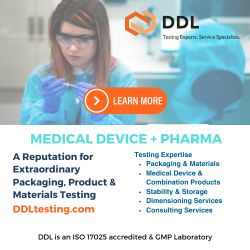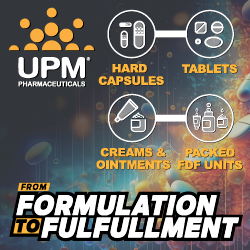Bio Platforms
Cidara Therapeutics Announces Completion of Dosing the First Cohort of Healthy Volunteers in Phase 1 Trial
Cidara Therapeutics, Inc. recently announced the first cohort of healthy volunteers has been dosed in its Phase 1 trial of CD388, a highly potent long-acting…
Vyant Bio & OrganoTherapeutics Announce Strategic Collaboration
Vyant Bio, Inc. and OrganoTherapeutics recently announced they have entered into a collaboration agreement to work toward accelerating the discovery of drugs for the treatment of….
Qualigen Therapeutics Engages TD2 as Contract Research Organization for Preclinical Development
Qualigen Therapeutics, Inc. recently announced it has appointed the renowned contract research organization (CRO) Translational Drug Development (TD2) to lead the preclinical development of lead…
Mapi Pharma Receives US Patent Covering Methods of Suppressing or Alleviating Primary or Secondary Progressive MS With a Sustained-Release Glatiramer Acetate Depot
Mapi Pharma Ltd. recently announced it has been granted US Patent No. 11,167,003 titled Methods for suppressing or alleviating primary or secondary progressive multiple sclerosis….
eTheRNA Manufacturing Announces New LNP Formulation Development & Production Service
eTheRNA Manufacturing recently introduced a new Lipid Nanoparticle (LNP) formulation development and production service to support the discovery and early preclinical development of RNA-based….
Artizan Biosciences Announces Issuance of New US Patent to Cover Proprietary Discovery Platform
Artizan Biosciences, Inc. recently announced the US Patent and Trademark Office has issued US Patent No. 11,299,790 that broadens the use of the company’s proprietary…
Gb Sciences' Nanoparticle Encapsulation Technology Improves the Efficacy of Terpenes for Use in Chronic Pain Formulations
Gb Sciences, Inc. recently announced its sponsored study investigating the effect of nanoparticle encapsulation of three cannabis-based terpenes on their potential efficacy in pain management was….
Albireo Completes Enrollment in Pivotal Phase 3 ASSERT Study
Albireo Pharma, Inc. recently announced the completion of patient enrollment in the ASSERT study, a Phase 3 pivotal trial of Bylvay (odevixibat) in patients with…
Artelo Expands Collaboration With Trinity College Dublin to Investigate Cellular Biology of Fatty Acid Binding Protein Inhibition in Cancer
Artelo Biosciences, Inc. recently announced it has entered into a second collaboration with Richard K. Porter, PhD, of the School of Biochemistry & Immunology at….
Ionis & Biogen Announce Topline Phase 1 Study Results
Ionis Pharmaceuticals, Inc. & Biogen, Inc. recently announced topline results from the Phase 1 study of BIIB078 (IONIS-C9Rx), an investigational antisense oligonucleotide (ASO) for people…
European Medicines Agency Commences Review of Novel Gene Therapy Candidate for People With Hemophilia B
CSL Behring recently announced the European Medicines Agency (EMA) has accepted the Marketing Authorization Application (MAA) for etranacogene dezaparvovec (EtranaDez) under its accelerated assessment procedure.…
RAPT Therapeutics Announces Biomarker Data from Phase 1b Trial
RAPT Therapeutics, Inc. recently announced biomarker data from the company’s randomized placebo-controlled Phase 1b clinical trial of RPT193 in patients with moderate-to-severe atopic dermatitis (AD)…
Prothena Announces FDA Clearance of IND for PRX012, a Subcutaneous Anti-Amyloid Beta Antibody Under Investigation for the Treatment of Alzheimer’s Disease
Prothena Corporation plc recently announced the US FDA has cleared the investigational new drug (IND) application for PRX012, a potential best-in-class anti-amyloid beta (Aβ) antibody…
Provectus Biopharmaceuticals Announces Synthesis of New Halogenated Xanthene Small Molecule
Provectus recently announced it has successfully developed and manufactured a second halogenated xanthene (HX), adding to its lead, clinical-stage, HX small molecule called rose bengal…
Rani Therapeutics Announces Initiation of Phase 1 Study for Osteoporosis
Rani Therapeutics Holdings, Inc. recently announced the initiation of a Phase 1 study of RT-102, an oral formulation of the human parathyroid hormone analog PTH(1-34)…
GeoVax Announces Issuance of Cancer Vaccine Patent
GeoVax Labs, Inc. recently announced the U.S. Patent and Trademark Office has issued Patent No. 11278607 to GeoVax, pursuant to the company’s patent application No. 16/068,527 titled….
Viridian Therapeutics Doses First Subject in First-in-Human Clinical Trial Evaluating a Next- Generation IGF-1R Antibody
Viridian Therapeutics, Inc. recently announced it has dosed the first subject in a Phase 1 clinical trial evaluating VRDN-002 for the treatment of thyroid eye…
Jeune Aesthetics Announces Positive Clinical Phase 1 Efficacy Results for Investigational Gene-Based Treatment to Address the Underlying Biology of Aging Skin
Jeune Aesthetics, Inc., a wholly owned subsidiary of Krystal Biotech, Inc., recently announced positive proof-of-concept efficacy data from Cohort 2 of the PEARL-1 study of KB301….
Blue Water Vaccines Announces Publication in Nano Research Supporting Novel S&P Vaccine Platform Versatility
Blue Water Vaccines Inc. recently announced its licensing partner, Cincinnati Children’s Hospital Medical Center, or CCHMC, has published a research paper titled Bioengineered pseudovirus nanoparticles…
Travere Therapeutics Submits NDA for Sparsentan for the Treatment of IgA Nephropathy
Travere Therapeutics, Inc. recently announced it has submitted a New Drug Application (NDA) to the US FDA under Subpart H for accelerated approval of sparsentan…
What are Bio Platforms?
Platforms (or asset-independent technologies to capture all kinds of capabilities that can be leveraged across many different drug candidate assets rather than just discovery tools that the term ‘platform’ immediately brings to mind) are ubiquitous in modern pharma. They are the product of an arms race, to secure access to the best capabilities in key areas.
Platform technologies are considered a valuable tool to improve efficiency and quality in drug product development. The basic idea is that a platform, in combination with a risk-based approach, is the most systematic method to leverage prior knowledge for a given new molecule. Furthermore, such a platform enables a continuous improvement by adding data for every new molecule developed by this approach, increasing the robustness of the platform.
But it has often been said that access to the latest technological platforms to aid efficient drug discovery and development is limited to Big Pharma, which can more easily justify the costs of creating and operating these platforms.
Benefits of Bio Platforms
Platform technologies have the ability to radically improve upon current products and generate completely novel products. In this sense, they open up new arenas for drug discovery and development, potentially increasing the number of therapeutic options for patients. Once a single compound or therapeutic has been generated and demonstrates a clinical benefit in patients, it is more likely this platform technology can successfully be applied to other therapeutic areas, derisking future compounds/products.
Complex drugs by their very nature are challenging and costly to manufacture. This, in turn, translates into higher costs for patients and other payers. In order to provide safe and effective therapies at a reasonable price, it is necessary for the industry to develop manufacturing technologies that reduce costs and provide a consistent product. While the initial investment may be larger, manufacturing costs will be lower over time as the manufacturing process is solidified.
Scale and Investment of Bio Platforms
Despite the initial upfront costs, platform technologies inevitably provide pragmatic solutions to production challenges, while yielding safer and more effective therapeutic products. It has often been said that one of the key features that distinguishes “Big Pharma” from biotech is access to the latest technological platforms to aid efficient drug discovery and development.
These platforms range from vast chemical libraries, ultra-high throughput screening and huge genetic databases in discovery, to predictive toxicology platforms, cutting-edge ‘omics’ and even deep-seated knowledge of particular therapeutic areas in development. All these platforms have two things in common: They can be used on any (or many) development candidate assets, and they cost huge sums to establish in the first place, and in a few cases each time they are used as well. Hence their restriction to the largest pharmaceutical companies (and a few of the so-called “big biotechs” that are, in many ways, indistinguishable from the old-guard pharma).
Only when you have hundreds of active projects can you justify the cost of creating and operating these platforms. Or so the mantra goes. It is access to these platforms that keeps the big companies ahead in the race to discover and develop the best medicines (or at least counterbalance the disadvantages of being large and slow-moving, depending on your point of view). But is that just an assertion? How much evidence is there to support the proposition that the efficiency gains due to these platforms outstrips the cost of creating and maintaining them?
Keeping these technologies “cutting edge” has become so expensive that increasingly we hear pharma companies talking of “pre-competitive” approaches to develop the next generation. A group of companies might develop a platform capability they then share. The principle goal of such initiatives is to access even grander and more expensive tools than individual companies could afford, rather than to dramatically cut costs (although sharing platforms rather than developing the same thing in parallel in each silo should at least keep a lid on rising costs).

















